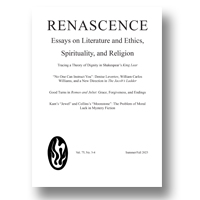|
|
|
1.
|
Renascence:
Volume >
67 >
Issue: 3
Brent Little
Forgiveness and the Limits of Language in The Shrine at Altamira
abstract |
view |
rights & permissions
| cited by
Jacques Derrida’s description of forgiveness as a kind of “madness” certainly applies to John L’Heureux’s novel, The Shrine at Altamira (1992). In the novel’s climax, forgiveness is manifested between Russell Whitaker and his son John through an incomprehensible tragedy. But although the novel harmonizes with much of Derrida’s thought, it resists a complete coherence. This article will explore the gaps between the novelistic and philosophic discourses on the subject of forgiveness. I argue that while the story painfully portrays an event of “forgiveness” as a “madness,” it also challenges conceptual articulations of forgiveness and thereby exposes both the necessity and the limits of language. The novel thus compels the reader to make a choice more existential than theoretical: one can either see the act of forgiveness as meaningless, or one can allow the possibility of hope, a hope weak and illogical to be sure, but a hope that refuses to grant tragedy the last word.
|
|
|
|
|
|
|
2.
|
Renascence:
Volume >
67 >
Issue: 3
Mary Ann Melfi
The Dark Night of the Soul: Suffering the Cure in Graham Greene’s A Burnt-Out Case
abstract |
view |
rights & permissions
| cited by
Set in the Congo, A Burnt-Out Case owes a debt to Conrad’s Heart of Darkness, a novel Greene explicitly mentions in his text. However, in Greene’s novel we see an exposition of a redemptive process that is significantly different from Conrad’s dark view of what lies, at its deepest level, within man. Using St. John of the Cross’s Dark Night of the Soul as a touchstone, Greene illuminates significant stages in his protagonist’s cure from ennui, aridity, and despair. Greene’s Congo is a region of the mind revealing an essential immaturity in man which can be overcome through suffering and the gift of grace.
|
|
|
|
|
|
|
3.
|
Renascence:
Volume >
67 >
Issue: 3
Patrick Garrett York
The Glory of Grace: Mystery in the Works of C. S. Lewis and Flannery O’Connor
abstract |
view |
rights & permissions
| cited by
Despite their differences, C.S. Lewis and Flannery O’Connor share a connection in their treatment of theological and ontological issues in their fiction and criticism. Reading their work dialectically challenges claims by their critics that these authors’ Christianity and its effect on their work consign them to the categories of “evangelist” or “propagandist” rather than “artist.” Instead, through the construction of a critical conversation between O’Connor’s “The Lame Shall Enter First” and Lewis’ Til We Have Faces, I argue that, as artists, their religious identification allows them, through the use of a sacramental aesthetic, to imbue secular subjects in their literature with a sense of mystery, grace, and glory, accessible and relevant to both religious and non-religious readers.
|
|
|
|
|
|
|
4.
|
Renascence:
Volume >
67 >
Issue: 3
Christopher Wachal
Tremendous Frontiers — Flannery O’Connor and the Catholic Writer’s “True Country”
abstract |
view |
rights & permissions
| cited by
Few Catholic writers are identified as immediately with a location as Flannery O’Connor is with the American South. Southern manners and grotesqueries dominate her short stories. Critical conversations have tended to take narrow this regional designation – “Southern Catholic writer” – to its most provincial interpretation, thus narrowing the possible meanings of place in O’Connor’s stories. This restriction runs counter to the author’s proclamations that Christian writers like her inhabit a “larger universe” than their secular neighbors. The purpose of this essay is to examine the relationship between location, nation, and faith in O’Connor’s short fiction. Specifically, it reads the complex obligations represented in “The Displaced Person” in light of both influxes of European immigrants to the American South after World War II and O’Connor’s multi-national Catholic intellectual heritage. It seeks to locate Catholic fiction in an aesthetic of displacement and statelessness – a religious aesthetic that requires contemplating the tremendous borders that demarcate and delimit the author’s “larger universe.”
|
|
|
|





